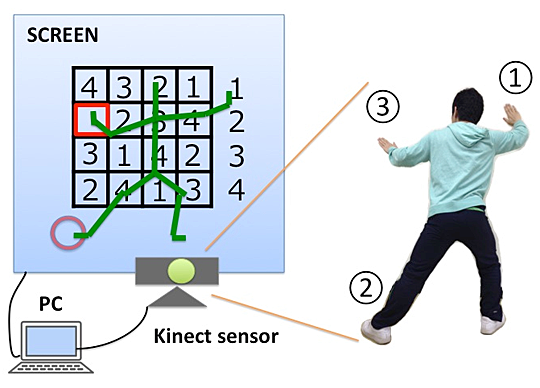Kinect for Windows shows promise in helping seniors retain cognitive functions
Declines in cognitive function are among the most debilitating problems that affect senior citizens. Various studies have reported that physical training designed to prevent falls can have a positive effect on cognition in older adults. With that in mind, Japanese researchers at Kyoto University’s medical school employed Kinect for Windows to create Dual-Task Tai Chi, a unique game concept in which elderly participants use various body movements and gestures—captured by the Kinect sensor and relayed to a stick figure projected on a screen—to select numbers and placements to complete an on-screen Sudoku puzzle. The game thus involves two tasks: the coordination task of controlling the stick figure, and the cognitive task of figuring out the puzzle pattern.

The patient uses movements and gestures—which are detected by the Kinect sensor—to complete an
on-screen Sudoku puzzle.
Forty-one elderly participants were divided into a test group (26 individuals) and a control group (15 individuals). After 12 weeks, the test group showed improved cognitive function compared to the control group, as measured by the trail-making test—which measures visual attention and task switching abilities—and a verbal fluency test (see note). While the researchers caution that the results are preliminary, they demonstrate yet another way that Kinect for Windows can help improve health and well-being.
Kinect for Windows Team
Key links
- See other Kinect for Windows healthcare applications in action
- Read the original research paper
- Tell us about your solutions on Facebook and Twitter
____________
Note: As the investigators' research paper states, “Significant differences were observed between the two groups with significant group x time interactions for the executive cognitive functions measure, the delta-trail-making test (part B—part A; Fi.36= 4.94, P = .03; TG: pre mean 48.8 [SD43.9], post mean 42.2 [SD 29.0]; CG pre mean 49.5 [SD 51.8], post mean 64.9 [SD 54.7].” Read the research paper for more details.